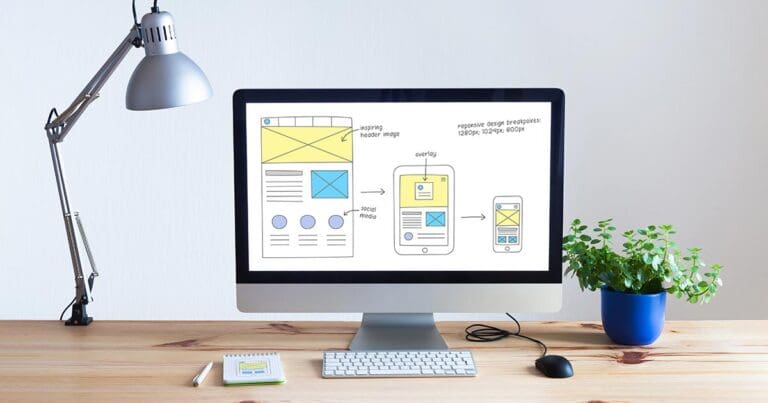UI&UX Design Trends to Future-Proof Your Business

In today’s fast-paced digital landscape, staying ahead of the curve is crucial for businesses looking to future-proof their success.
One area that cannot be ignored in this pursuit is UI&UX design.
As technology continues to evolve and user expectations become increasingly sophisticated, organizations must keep a finger on the pulse of the latest design trends to provide seamless, intuitive, and visually stunning experiences.
To understand why incorporating these trends is vital for businesses aiming to thrive in the modern era, it’s important to explore the top UI&UX design trends that are shaping the industry.
What is UI&UX design?
UI stands for user interface and is the bridge between users and technology, determining what users see and how they interact with it. UX, or user experience, refers to the overall feeling a person has when using a product or service. Together, they focus on delivering an enjoyable, intuitive, and efficient user journey.
16 Growing UI&UX Design Trends
- Mobile Optimization
- Inclusive Design
- Empathetic Design
- End User Feedback
- User Data Incorporation
- Interconnectivity
- Function-Specific Design
- Micro-Interactions
- Motion Design Animation
- Voice User Interface (VUI)
- Gesture Control Navigation
- Dark Mode Design
- Glassmorphism
- Neumorphism
- Senior-Friendly Design
- UX Designers Working with Tech Engineers
1. Mobile Optimization
With the majority of users accessing content via mobile devices, mobile optimization is no longer optional but paramount.
This design trend involves ensuring websites and applications are aesthetically pleasing and functional on mobile screens of varying sizes.
It includes intuitive navigation, easy readability, fast load times, and touch-friendly elements.
Businesses that prioritize mobile optimization enhance the user experience, potentially increasing audience engagement and conversion rates.
2. Inclusive UI&UX Design
Inclusive design aims to create digital products accessible and usable by a diverse range of users, regardless of their abilities, physical limitations, or technical know-how.
This design trend emphasizes the importance of designing interfaces that cater to the needs of users with different physical, cognitive, and sensory abilities.
It includes elements such as color contrast, closed captions, and compatibility with assistive technologies like screen readers.
By adopting inclusive design, businesses not only comply with legal requirements but also expand their customer base by creating an inclusive digital environment accessible to all.
3. Empathetic UI&UX Design
Empathetic design focuses on understanding and addressing the emotional needs of the users.
This design trend goes beyond usability, seeking to evoke positive emotions and create a deep connection between users and the product or service.
Empathetic design considers factors such as tone, aesthetics, and personalization, aiming to create experiences that resonate on an emotional level.
By adopting empathetic design, businesses can significantly improve user satisfaction, foster loyalty, and enhance their brand’s emotional appeal.
4. End-User Feedback
This design trend recognizes that the end users are the best judges of what works and what doesn’t in a design.
It involves sourcing opinions, suggestions, and criticisms directly from the users and incorporating them into the design process.
Techniques such as user surveys, feedback forms, and usability testing are often employed to gather this essential feedback.
By prioritizing end-user feedback, businesses can ensure that their UI&UX designs are not only visually appealing but also fulfill the practical needs and preferences of the users.
5. Usage Data Incorporation
Usage data incorporation involves leveraging user data to understand the behavior of users and improve their experience.
It involves analyzing usage patterns to identify areas for improvement, such as high abandonment rates or slow page loads.
This design trend also incorporates A/B testing to compare different designs and determine which works best for users.
By relying on usage data, businesses can make informed design decisions and create an optimal experience tailored to the needs of the users.
6. Interconnectivity
Interconnectivity is a design trend that seeks to integrate multiple products, services, and platforms into a cohesive whole.
This allows users to access information from different sources without having to leave their current environment.
It involves creating connections between different devices, systems, and services to allow a seamless experience across platforms.
Interconnectivity is essential for businesses that wish to provide a frictionless user experience while maintaining control of their data and user interactions.
7. Function-Specific UI&UX Design
Function-specific design focuses on tailoring the design to specific tasks, roles, or functions, thereby enhancing usability and efficiency.
This trend can be particularly beneficial in complex applications where different users have varying responsibilities and requirements.
Function-specific design includes creating workflows that align with user roles, task-based navigation, and interfaces that highlight the tools and information specific to the user’s role.
By employing function-specific design, businesses can provide a personalized experience that boosts productivity and reduces the learning curve for users.
8. Micro-Interactions
Micro-interactions are subtle design elements that respond to user behavior and provide feedback.
These design elements can include animations that indicate loading status, subtle changes in button colors upon clicking, or a small vibration to confirm an action on a mobile device.
They add a layer of interactivity and responsiveness to the user interface, making the user feel acknowledged and engaged.
Businesses that effectively use micro-interactions can significantly enhance user engagement and satisfaction, thereby creating a more intuitive and enjoyable user experience.
9. Motion Design Animation
Motion design animation is a rising trend in UX and UI design that involves using dynamic graphics to enhance user interaction and engagement.
Well-executed animations can improve user experience by guiding attention, providing feedback, and making the interface more intuitive.
With advancements in technology and browser capabilities, designers can now incorporate complex animations without compromising performance.
10. Voice User Interface (VUI)
VUI is a rapidly evolving trend in UI&UX design that focuses on the development of interfaces that allow users to interact with systems through voice commands.
This technology leverages advanced AI features and natural language processing to understand and respond to user voice instructions.
The goal of VUI is to create a hands-free, eyes-free experience that is especially useful for visually impaired users, multitaskers, or those who prefer voice interaction over traditional input methods.
By incorporating VUI into their design strategy, businesses can provide a seamless user experience that meets the evolving expectations of modern users.
11. Gesture Control Navigation
Gesture Control Navigation is gaining increasing significance with the proliferation of touch-sensitive devices and those that interpret physical gestures as input commands.
This mode of interaction provides a more immersive and intuitive user experience, as actions like pinching to zoom, swiping to navigate, or shaking to undo become instinctive responses.
Moreover, advanced technologies are now enabling more sophisticated gesture recognition, such as 3D gestures in the air, facilitating hands-free and more natural interactions with devices.
Businesses that effectively leverage gesture control navigation can deliver a more engaging and futuristic user experience, thereby gaining a competitive edge in the tech-savvy digital landscape.
12. Dark Mode UI&UX Design
Dark mode design has gained significant traction in recent years, largely due to its trendy aesthetics and potential eye comfort.
This design trend involves the use of a dark color scheme in user interfaces, often with a dominant black or dark gray color.
While some users prefer dark mode for its ability to reduce eye strain in low-light environments, others appreciate it for its battery-saving advantages on OLED and AMOLED screens.
However, it’s crucial to note that dark mode design is still a choice. Designers need to ensure that their platforms offer both light and dark modes, enabling users to select the one that best suits their needs and preferences.
13. Glassmorphism UI&UX Design
Glassmorphism is a design trend that leverages soft, transparent shapes and shading to create a unique, sophisticated aesthetic.
This trend allows the layering of multiple elements on top of each other without compromising legibility or clarity.
It also uses light gradients to create a sense of depth and fluidity, making interfaces look more futuristic and visually appealing.
Glassmorphism allows designers to create unique user interfaces that stand out without compromising functionality, thereby helping businesses stay ahead of the competition.
14. Neumorphism UI&UX Design
While we’re discussing “morphisms”, neumorphism is a relatively new trend in UI&UX design.
This design style showcases soft, raised elements on a white background that gives the illusion of pressing a button or interactive element.
The unique visuals created by neumorphism are especially effective for creating engaging elements such as switches, toggles, and selectors.
By leveraging this trend sparingly, businesses can create a user experience that provides users with a more tactile experience.
15. Senior-Friendly UI&UX Design
Senior-friendly design is an increasingly important trend in UI&UX design, especially for products targeting the older demographic.
This design approach emphasizes accessibility, simplicity, and high-contrast visuals to cater to the unique needs and preferences of older adults.
It includes larger text sizes, intuitive navigation, and clear, concise instructions to enhance usability for those who experience challenges such as impaired vision or decreased motor skills.
By incorporating a senior-friendly design, businesses can create a user experience that is inclusive, allowing users of all ages to interact with their products effectively.
UI UX Designers Working with Tech Engineers
Collaboration between UX designers and tech engineers is a critical aspect of successful product development.
This partnership goes beyond simply translating design ideas into functional code.
In fact, it involves a continuous dialogue, with designers understanding the possibilities and limitations of technology, and engineers attaining an appreciation for user-centered design principles.
The cohesive synergy between these two disciplines fosters innovation, facilitates problem-solving, and ultimately leads to the creation of more user-friendly and technologically robust digital products.
It’s important to note that while this isn’t a design trend, it’s a crucial process that drives the successful implementation of all design trends.
Why these UI&UX design trends are important
These UI&UX design trends are important to remain on the cutting edge due to shifts in user behavior, technological advancements, and overall business benefits.
Shift in user behavior driving UI&UX design
As users become more tech-savvy, their expectations are evolving rapidly, with a heightened demand for more interactive, intuitive, and personalized interfaces.
As such, it’s crucial for businesses to stay updated with emerging UI&UX trends, adapting their design approaches accordingly to meet these changing expectations.
This dynamic approach not only enhances user satisfaction but also plays a pivotal role in maintaining a competitive edge in the digital marketplace.
Technological advancements in UI&UX design
Advancements in technology are enabling designs that are more sophisticated, immersive, and user-friendly.
High-tech capabilities, such as Artificial Intelligence (AI) and Virtual Reality (VR), are being utilized to create designs that can learn from and adapt to user behavior, thereby offering a more personalized and engaging experience.
Meanwhile, enhanced processing power and advanced graphic capabilities have afforded designers the ability to create high-definition, visually stunning interfaces that were previously unattainable.
Business benefits of UI&UX design
Enhanced user engagement is a direct outcome of implementing these UI&UX design trends, as they create a more immersive and user-friendly experience that encourages users to interact with the product longer.
As a result, businesses can also observe a significant reduction in bounce rates, as users are less likely to abandon the website or app due to an appealing, intuitive interface.
This improved user experience can potentially lead to increased conversions, as users are more likely to complete desired actions when they enjoy interacting with the product.
UI UX design jobs to hire & UI UX Designer salary
There are several UI UX design jobs to hire including UX directors, creative directors, UX Researchers, information architects, and front-end developers.
- UX Director
- UI UX Designer
- Creative Director
- UX Resarcher
- UX Developer
- Information Architect
- Front-End Developer
- UX Contractor
UX Director salary & description
The average UX director salary range is $130,000-$198,000.
A UX Director works with upper management to lead a team of UX designers and oversee all aspects of the user experience.
UI UX Designer salary & description
The average UI/UX designer salary range is $80,000-$160,000.
A UI UX Designer is responsible for creating user-friendly interfaces and experiences, utilizing a mixture of graphic design, programming, and user psychology skills.
Creative Director salary & description
The average creative director salary range is $120,000-$210,000.
A Creative Director in the realm of UX/UI design sets the overall creative and strategic vision for a project, ensuring the design team’s work aligns with the company’s brand identity and user expectations.
UX Researcher salary & description
The average UX researcher salary range is $80,000-$156,000.
A UX Researcher employs various techniques, such as user interviews, surveys, and usability tests, to gather insights about user needs and behaviors, thereby informing and improving the design process.
UX Developer salary & description
The average UX developer salary range is $90,000-$160,000.
A UX Developer bridges the gap between design and development, implementing designs in code while ensuring functionality and preserving the integrity of the user experience.
Information Architect salary & description
The average information architect salary range is $130,000-$175,000.
An Information Architect organizes and structures the information on a website or app to ensure seamless navigation and improved user experience.
Front-end Developer salary & description
The average front-end developer salary range is $96,000-$180,000.
Front-end Developers are responsible for creating the visible part of a website or application, using coding languages such as HTML, CSS, and JavaScript to implement design and ensure its functionality across various platforms and devices.
UX Contractor salary & description
The average UX Contractor salary range is $80,000-$210,000.
A UX Contractor, often hired on a project basis, utilizes their expertise in user experience design to help businesses enhance the usability and appeal of their digital products.
UI&UX Design to Future-Proof Your Business
In the dynamic world of digital business, keeping pace with the most recent UX/UI trends is not just beneficial, but integral for maintaining a competitive advantage.
A multi-disciplinary team, ranging from UX Research to Front-End Development, has the ability to adeptly utilize these trends to craft superior user experiences, which directly translates to higher user engagement and better return on investment (ROI).
It’s not merely advantageous, but crucial for businesses to rigorously assess their current design methodologies and adapt to the fluctuating demands of the digital marketplace.
Investing in continuous learning opportunities for existing teams, or bringing in fresh talent with the latest know-how, can be a lucrative strategy.
This enables the harnessing of cutting-edge design trends, driving improved user satisfaction, increased conversion rates, and ultimately, bolstering business success.
Looking to hire top-tier Tech, Digital Marketing, or Creative Talent? We can help.
Every year, Mondo helps to fill over 2,000 open positions nationwide.
More articles about hiring and industry trends:
- Understanding GenAI and Maximizing Its Potential in Business
- The Future of Recruiting: Top 10 Challenges in Tech and Digital Hiring
- Boomers, Millennials & Zoomers: From Tradition to Transition in the Job Market
- How To Conquer the Top 10 Most Common Recruitment Challenges
- The Rise of Working Moms & the Role of Remote Work
- How to Recruit Top Data Scientists in a Competitive Job Market
- Lessons From Unicorn Companies: Hiring Strategies for Rapid Growth
- 8 Myths About Hiring Gig Workers Every Employer Should Know
- The Costly Consequences of Project Delays and How To Prevent Them
- Big Tech Job Cuts Don’t Mean Demand for Tech Professionals Is Over



